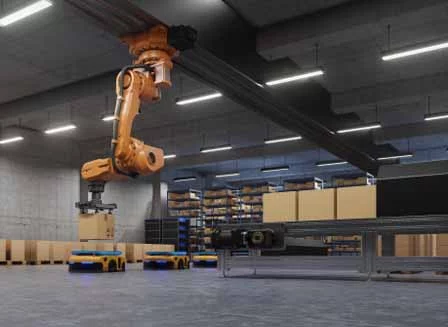Introduction to Warehousing Efficiency in Modern Logistics
Automation, particularly palletizing robots, has altered warehouse operations and is now a prominent participant in the ever-changing logistics industry. As businesses attempt to fulfill the needs of a worldwide market, the use of robotics in logistics is turning from a trend to a strategic move.
The Emergence of Palletizing Robots in Warehouse Operations
The logistics industry has benefited greatly from palletizing robots‘ incredible precision and dependability for stacking and organizing a wide range of products. Robots that perform palletizing have completely changed the way warehouse management is done. They have made palletizing faster and more accurate, and some of these machines can work continuously to meet the demands of e-commerce platforms and global supply chains, which depend heavily on accuracy and speed. Automation of palletizing has also lessened the physical strain that warehouse workers must bear in order to maintain an atmosphere that is secure and productive.
These robots are being used in more warehouse applications because to their customizable grippers, programming, and capacity to handle different package shapes and sizes. This adaptability makes palletizing robots invaluable assets in logistics, capable of enhancing operational efficiency across various sectors.

Spotlight on a Cutting-Edge Palletizing Robot: QJRB30-1
Among the various models available, the QJRB30-1 stands out with its exceptional capabilities. This robotic arm boasts a payload of 30kg and an impressive reaching distance of 1820mm. Its technical prowess is evident in its high-speed, stable operations, and all axis operating at low power output. The simplicity in equipment composition, paired with specialized palletizing software, makes the QJRB30-1 a remarkable asset in warehouse automation. Its repeat positioning accuracy of ±0.05mm ensures precision in handling goods, crucial in a logistics environment where every millimeter counts.

Advantages of Palletizing Robots in Logistics
Palletizing robot integration in logistics offers many benefits beyond increased productivity and efficiency. The main benefit is a notable decrease in operational expenses; by automating the palletizing process, businesses can save labor costs related to manual stacking and lower the frequency of workplace accidents and associated costs.
In addition to cost savings, palletizing robots offer unparalleled precision and consistency, which is critical in logistics operations. This level of accuracy ensures that products are handled and stored correctly, reducing the risk of damage and subsequent loss. As a result, companies can maintain higher standards of product integrity and customer satisfaction.
The scalability of palletizing robots is another important benefit; as companies expand and their requirements change, these robots can be reprogrammed and modified to handle higher volumes or different product types. This scalability guarantees that businesses can respond to market changes without having to make substantial additional investments in new equipment or employee training.

Palletizing robots carry out physically taxing and repetitive duties linked to a decreased risk of musculoskeletal disorders and other frequent illnesses like sprains and strains that are often connected with manual palletizing. This lower risk of injury at work also boosts worker morale and job satisfaction.
Palletizing robots are a last step towards a more sustainable logistics sector. They maximize warehouse space utilization and cut waste by increasing stacking accuracy. Additionally, by running more efficiently, businesses can use less energy and produce less carbon dioxide, which supports eco-friendly practices in the sector.
Integration of Palletizing Robots: Technical and Operational Aspects
The QJRB30-1 can be seamlessly integrated into an existing warehouse system. Its versatility for many logistics operations comes from its ability to work with various pallet types and adapt to different product types; its sophisticated software and easy-to-implement design minimize any disruption to the warehouse’s current infrastructure, which is important for warehouses looking to upgrade operations without too much disruption.
Future Trends: Palletizing Robots and the Evolution of Logistics
Future logistics will undoubtedly be closely linked to robotics developments. As technology advances, palletizing robots—like the QJRB30-1—should grow increasingly complex. The logistics sector will gain from robotics technology’s greater efficiency, adaptability, and cost-effectiveness. Their use should increase in both large-scale operations and smaller facilities.
Conclusion
QJRB30-1 is a prime illustration of how robotics integration may usher in a new era of warehouse automation, greatly effecting the growth and evolution of the industry. Palletizing robots have transformed warehousing efficiency, and their role will only increase as logistics improve. Modern technology has the ability to change operations and make warehouses safer, more productive, more efficient. Explore more about robotics in logistics at EVS Int.
